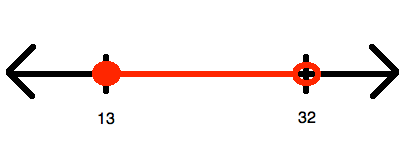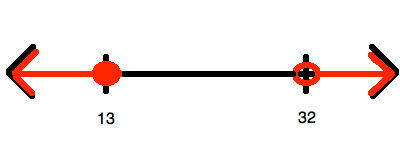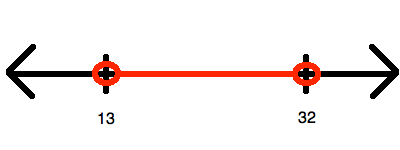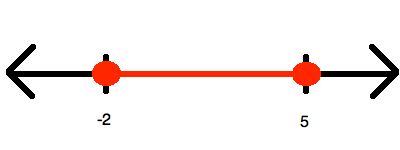All GRE Math Resources
Example Questions
Example Question #1 : Other Number Line
The range of the earnings for architecture graduates is 

Which of the following statements individually provide(s) sufficient additional information to determine the range of the salaries of all graduates between the two professions?
A: The median salary for the engineers is 
B: The average (arithmetic mean) of the engineers is 
C: The lowest salary of the engineers is 
A, B, and C
A only
A and C only
C only
B only
C only
The provision of the bottom-end of the engineering range is the only additional information that provides us a fixed endpoint from which we can build off of by supplementing with the ranges provided in the question, to give us the full range between both engineering and achitecture graduates. See the diagram provided to understand how this can be done.
Even if the mean and medians were provided, these additional values give us no information on the endpoints of the salaries, and the question only asks for the range.
Example Question #114 : Arithmetic
What's the distance between 

Let's draw a number line.

Since a number line is straight and contains the numbers consecutively, we just subtract 


Example Question #3 : How To Find Value With A Number Line
Which of the following answer best fits in the picture below?

Open circles mean the values are excluded from the set.
The number line shows the set is between 

The only value in that set would be 
Example Question #1 : Number Line
If 

Because a number line contains both positive and negative integers, we need to consider both possibilities.






Next 





Then, we should guess that 


Remember, a negative value raised to an even power will always have a positive value.
Example Question #2 : Other Number Line
If perimeter of equilateral triangle is 
Since perimeter of equilateral triangle is 


The height is opposite the angle 







Let's simplify by factoring out 

Example Question #1 : Number Line
On a real number line, x1 = -4 and x2 = 14. What is the distance between these two points?
-18
18
4
10
18
The distance between two points is always positive. We calculate lx2 - x1l, which will give us the distance between the points.
|14- (-4)| = |14+4| = |18| = 18
Example Question #2 : Number Lines And Absolute Value
Which of the following is a graph for the values of 






To begin, you must simplify so that you "isolate" 

Now, this inequality represents all of the numbers between 13 and 32. However, it does include 


Example Question #1 : How To Graph An Inequality With A Number Line

Which of the following inequalities is represented by the number line shown above?
Since the inequality represents one range of values between two end points (both of which are included, given the sign being "less than or equal"), you know that whatever you answer, it must be convertible to the form:
Now, you know that it is impossible to get this out of the choices that have no absolute values involved in them. Therefore, the only options that make sense are the two having absolute values; however, here you should choose only the ones that have a 
The wrong answer is simplified in this manner:
And you can stop right here, for you know you will never have 
The other option is simplified in this manner:
This is just what you need!
Example Question #2 : Number Line
Quantity A:
Quantity B:
The relationship cannot be determined.
Quantity B is larger.
The two quantities are equal.
Quantity A is larger.
Quantity B is larger.
It is not necessary to solve this problem by multiplying terms out. Notice that between quantities A and B, the last three terms switch places for the two large numbers. as such they can be rewritten:
Quantity A:
Quantity B:
Both quantities A and B share the exact same terms, save for two:
Quantity A:
Quantity B:
From visual inspection, it is clear that B is larger.
Example Question #122 : Arithmetic

Which of the following is true?
Since 


For the A, it is possible to choose values that make the statement false, for example 

C is always false.
All GRE Math Resources



























































